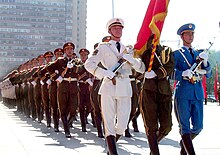| Revision as of 19:19, 31 March 2008 editEpaphroditus Ph. M.~enwiki (talk | contribs)411 edits Revert to revision 199333359 dated 2008-03-19 13:14:33 by 210.213.240.186 using popups← Previous edit | Revision as of 16:07, 2 April 2008 edit undoСанта Клаус (talk | contribs)Rollbackers213 editsm ar interwikiNext edit → | ||
| Line 51: | Line 51: | ||
| ] | ] | ||
| ] | |||
| ] | ] | ||
| ] | ] | ||
Revision as of 16:07, 2 April 2008
For other uses, see Army (disambiguation).| This article needs attention from an expert in Military history. Please add a reason or a talk parameter to this template to explain the issue with the article. WikiProject Military history may be able to help recruit an expert. |
- Colour key:
-
- Green: No armed forces
- Blue: Fully voluntary/professional army
- Orange: Conscription, but abolition of conscription decided upon (<to 3 years)
- Red: Conscription (in some cases limited)
- Grey: No information
An army (from Latin armata "act of arming" via Old French armée), in the broadest sense, is the land-based armed forces of a nation. It may also include other branches of the military such as an air force. Within a national military force, the word Army may also mean a field army, which is an operational formation, usually made up of one or more corps.
In several countries the army is officially called the Land Army to differentiate it from an air force called the Air Army, notably France.In such countries, the word "army" on its own retains its connotation of a land force in common usage. The current largest army in the world by number of active troops is the People's Liberation Army with 2,250,000 active troops and 800,000 reserve personnel.
Field Army
A Field Army is composed of a headquarters, army troops, a variable number of corps, and a variable number of divisions. A battle is influenced at the Field Army level by transferring divisions and reinforcements from one corps to another to increase the pressure on the enemy at a critical point. Armies are controlled by a General or Lieutienant General.
Formations


A particular army can be named or numbered to distinguish it from military land forces in general. For example, the First United States Army and the Army of Northern Virginia. In the British Army it is normal to spell out the ordinal number of an army (e.g. First Army), whereas lower formations use figures (e.g. 1st Division).
Armies (as well as army groups and theaters) are large formations which vary significantly between armed forces in size, composition, and scope of responsibility.
In the Soviet Red Army and the Soviet Air Force, "Armies" were actually corps-sized formations, subordinate to an Army Group-sized "front" in wartime. In peacetime, a Soviet army was usually subordinate to a military district.
For the hierarchy of land forcedom organizations, see military organization.
See also
- Military unit
- War
- Military history
- Paramilitary
- Militia
- Mercenary
- List of armies
- List of armies by country
- List of armies by number
- List of countries by size of armed forces
- List of countries by number of active troops
- List of countries by number of total troops
This military-related article is a stub. You can help Misplaced Pages by expanding it. |
| Army units and organization | |
|---|---|
| Subordinated element |
|
| Unit | |
| Formation |
|
| Command |
|
| Temporary | |